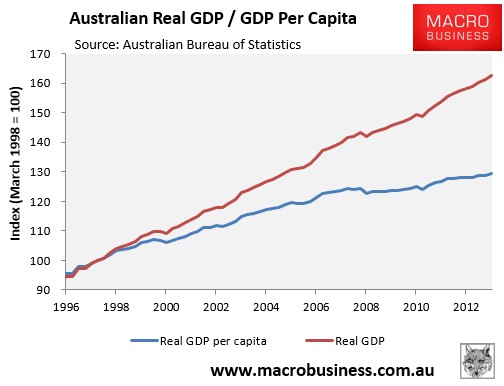
Business Spectator’s Callam Pickering has written another good piece today, this time questioning the merits of Australia’s world-beating immigration program, which risks lowering the living standards of the pre-existing population:
…high migration levels are not achieved without a cost. High population growth puts pressure on existing infrastructure and commonly leads to greater congestion on our roads and public transport. Not to mention the impact on our natural resources and environment.
There is also considerable debate as to whether high migration policies benefit the existing population. The Productivity Commission has found that… the real beneficiaries of migration are the immigrants themselves who benefit from higher domestic wages and relatively better infrastructure…
Unfortunately, it is doing little more than creating the illusion of growth…
Immigration is not a substitute for productivity and so far Australian residents are seeing little benefit from Canberra’s immigration policies…
The end result is an economy that is being driven by population growth, with little consideration of the long-term implications. How will we deal with the additional traffic congestion? What about increasing the housing supply? Does anyone care about the environment or natural resource depletion?..
Spot on. The key issue when it comes to Australia’s immigration policy is whether expanding Australia’s population by more than 1 million people every three years is beneficial to the existing population. Sure, while it might be great for Australia’s business elites – who enjoy the fruits of an expanded market – it imposes real costs on the rest of us, who must endure increased costs of congestion, higher housing/infrastructure costs, lower environmental amenity, and minimal uplift in material economic well-being.
From a narrow economic perspective, population growth (immigration) is good only if it raises the real incomes of the pre-existing population (e.g. real GDP per capita). While it is true that Australia’s high population growth over the second half of the 2000s boosted Australia’s real GDP (more labour inputs, other things equal, means more outputs), evidence is sketchy as to whether real GDP per capita increased due to population growth. In fact, as the below chart shows, real GDP per capita has remained lacklustre since 2007, suggesting that while the overall economic pie has increased in size because of high population growth, everyone’s share of that pie has barely grown.

The question around living standards becomes more important when infrastructure constraints and the environment are taken into account.
Indeed, a big negative of Australia’s high rate of population growth is that it is placing increasing pressure on the pre-existing (already strained) stock of infrastructure and housing, which reduces productivity and living standards unless costly new investments are made. Further, controversial and expensive investments like desalination plants would arguably not have been required absent such population growth.
Further, when infrastructure and housing investment fails to keep up, it places upward pressure on inflation, requiring higher interest rates, which can then damage productive sectors of the economy. As explained in a 2011 speech by the Reserve Bank of Australia’s Phil Lowe (summarised here), these factors were certainly in play in the late-2000s, when rapid population growth placed upward pressure on rents, as well as caused a big surge in utilities prices as the capacity of the system struggled to keep pace with the growing demand, requiring costly new investments.
Ongoing high population growth also places additional strain on the natural environment, causing greater environmental degradation, increasing water scarcity and pollution, and making it more difficult for Australia to reduce its carbon footprint and meet international pollution reduction targets.
A related concern is that Australia earns its way in the world mainly by selling its fixed mineral resources (e.g. iron ore, coal, natural gas, and gold). More people means less resources per capita. A growing population also means that we must deplete our mineral resources faster, just to maintain a constant standard of living.
As noted in part by Pickering, modelling by the Productivity Commission has also found that immigration is neither beneficial for the economy or living standards, nor can it alleviate the impacts of an ageing population.
All of which raises the question: what is the end-game of Australia’s current population-based economic model? If all we are doing is growing for growth’s sake, pushing against infrastructure bottlenecks, diluting our fixed endowment of minerals resources, and failing to raise the living standards of the existing population, where does it lead?

